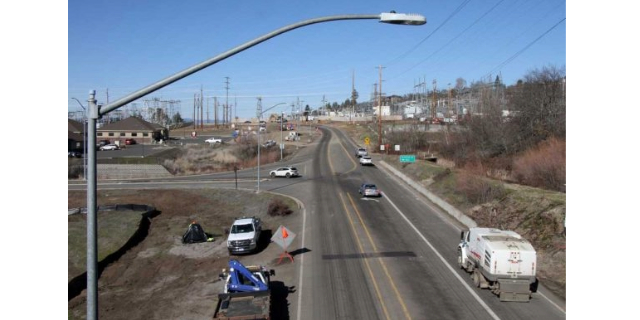US Supreme Court justices to meet Friday to consider monument expansion appeal
Published 3:30 pm Thursday, March 21, 2024

- The view looking north in 2020 from Hobart Bluff, about 10 miles southeast of Ashland, in the Cascade-Siskiyou National Monument.
U.S. Supreme Court justices are scheduled to meet in closed session Friday afternoon to decide if they want to take up appeals by timber industry groups, counties and others who oppose the 2017 expansion of the Cascade-Siskiyou National Monument.
Trending
A decision about whether to hear arguments in the case, which could extend a final decision into next year, might be made public Monday, according to Seattle attorney Kristen L. Boyles of the environmental law organization Earthjustice. The organization is representing the Ashland-based Soda Mountain Wilderness Council and the Klamath-Siskiyou Wildlands Center, along with Portland-based Oregon Wild, in opposing the appeals to the high court.
“I’m going to be looking on Monday morning,” said Boyles, who hopes that the justices decline to take up the matter, thus letting stand two appellate court decisions that affirmed the decision by then-President Barack Obama to expand the monument in January 2017 by about 47,000 federally owned acres, essentially putting those acres off limits to commercial logging.
The monument, located generally southeast of Medford, is now about 114,000 acres. Obama acted under authority of the 1906 Antiquities Act, which opponents argue is trumped by the 1937 O&C Act, which calls for sustained yield logging that helps fund county governments in Western Oregon.
Trending
If four of the nine justices agree, the court would take up the case.
“We think that would be a terrible idea,” Boyles said Wednesday in a telephone interview.
Justices typically take up cases that have broad or nationwide impact, but Boyles believes the issues in the case at hand are specific to “that one monument.” However, opponents of the expansion argue that the case involves the matter of presidential vs. congressional authority.
Opponents include the Jackson County Board of Commissioners, the Portland-based American Forest Resources Council and Murphy Company, which has mills in Rogue River and White City. Opponents also include U.S. Rep. Cliff Bentz, who represents Eastern Oregon and Jackson County in Congress.
“Previous administrations have used one person’s concepts — that is the president’s — to wreak havoc upon millions and millions and millions of acres and hundreds of small communities,” Bentz said in a Feb. 26 podcast posted to the AFRC website. “When I hear about the Antiquities Act, it’s an opportunity for a president to single-handedly direct, and many times damage, small communities out in the West.
“In some cases, such as with (the present case) it’s a violation of separation of powers. But more to the point, it’s an expansion of the executive branch’s power and authority over many lives and livelihoods out here in the West, and it’s wrong.”
Bentz, who is an attorney, said it wasn’t difficult to get 28 other members of Congress to join him in filing a brief with the court in December asking the justices to take up the case.
“It was a pretty easy sell when you point out the president is trying to step on Congress,” he said. “It gives the Supreme Court an opportunity to step in and clarify those respective powers.”
Locking up lands prevents the extraction of needed minerals, increases risks from wildfires and encourages visitors who would then “tramp on it and frankly ruin it,” Bentz said.
“If we lose, that is extraordinarily bad news for many of the situations we are now facing,” he said. “I just hope and pray this matter is managed appropriately by the court.”
The court has a heavy workload and typically accepts only 100 to 150 of the more than 7,000 cases that it is asked to review each year.
“Their challenge is to try to identify those things that are of greatest importance,” Bentz said. “I think this is of great importance.”
“The Antiquities Act is incorrectly deployed by too many presidents to affect negatively too many people,” he said. “It is my fervent hope the Supreme Court does the right thing and accepts our brief and then rules in our favor after argument.”
So far, appellate courts on the West Coast and in Washington D.C. have found in favor of the administration and the conservation organizations. Lower court decisions were split.
“This is framed by Murphy Company and the AFRC that this is some question about presidential power, and that’s just wrong,” said Boyles, the environmental attorney. “It’s about continued logging in that monument.”
2000: President Bill Clinton establishes the Cascade-Siskiyou National Monument, taking in about 65,000 acres of federally owned land in Southwestern Oregon, at the crossroads of the Klamath, Siskiyou and Cascade mountain ranges.
“This convergence of three geologically distinct mountain ranges has resulted in an area with unparalleled biological diversity and a tremendously varied landscape,” according to the U.S. Bureau of Land Management. “The Monument was established in 2000 in recognition of its remarkable ecology and to protect its diverse range of biological, geological, aquatic, archeological and historic resources.”
The monument, located at elevations of 2,100 to 6,100 feet, is home to deer, bear, mountain lions, small mammals, songbirds, eagles and other raptors. Activities there include hiking, wildlife viewing, fishing, hunting, skiing, snowmobiling and sledding.
2011: A group of 15 scientists from the local area raise concerns that the monument was “insufficient to preserve the biological diversity for which the monument was established.”
2015: In an open letter, 70 more scientists endorse expansion, with U.S. Sens. Ron Wyden and Jeff Merkley of Oregon introducing legislation to protect lands within an expanded monument.
The city councils and chambers of commerce of Ashland and Talent support expansion, as do numerous conservation groups, along with state Rep. Peter Buckley, Rep. Kevin Talbert and the late Sen. Alan Bates.
January 2017: Just before leaving office, President Barack Obama expands the monument by about 42,000 acres in Oregon and 5,000 acres in California, bringing the total monument area to about 114,000 acres. He does so under the authority of the Antiquities Act of 1906.
Later that year, the American Forest Resources Council, the Association of O&C Counties, Murphy Company and others sue the U.S. government to oppose the expansion, arguing that it violates the O&C Act of 1937, which calls for sustained yield logging on certain federal lands, 40,000 acres of which were absorbed into the monument by the expansion. Each side won cases at the lower court level before the government and conservation organizations won two appellate court decisions.
November 2023: The American Forest Resources Council, which represents more than 50 forest industry organizations, and others appeal to the U.S. Supreme Court. Council members include Boise Cascade, Roseburg Forest Products and Murphy Company, all of which have manufacturing operations in Jackson County.
Among those formally supporting the Supreme Court review are U.S. Rep. Cliff Bentz, R-Ore., and 28 members of Congress, plus county governments in Jackson, Josephine and Siskiyou counties. Those opposed to the court taking up the case include the U.S. Justice Department and Earthjustice, an environmental law organization in Seattle representing the Ashland-based Soda Mountain Wilderness Council and Klamath-Siskiyou Wildlands Center, along with Portland-based Oregon Wild.
Friday: Justices of the U.S. Supreme Court are scheduled to meet in private conference to determine if the court will take up the case and hear arguments at a later time.









